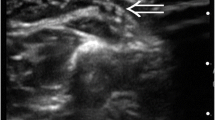Abstract
We evaluated the resistance to fluid infusion in the veins of 118 adult patients after intravenous catheter insertion prior to elective surgery. Hydraulic resistance in veins was defined as the slope of the pressure-flow relationship obtained by measuring venons pressure at several fluid flow rates. A resistance unit (RU) was defined as 1 mmHg/L/hr. Resistance in veins ranged from −12.1 to 732 RU, with 50th and 95th percentiles being 22 and 198 RU, respectively. Venons resistance was not significantly affected by site of catheter insertion, tissue characteristics at the insertion site, age, sex, patient anxiety, American Society of Anesthesiologists physical status, or catheter size. This report provides a distribution of resistance to fluid infusion in arm veins of adult patients.
Similar content being viewed by others
References
Philip JH. A model for intravenous fluid administration. Proc of IEEE/EMBS Ninth Annual Conference, Boston MA 1987: 1351–1353.
Philip BK, Philip JH. Characterization of flow in intravenous infusion systems. IEEE Trans Biomed Eng 1983: 30: 702–707
Philip BK, Philip JH. Characterization of flow in intravenous catheters. IEEE Trans Biomed Eng 1986: 5: 529–531
Philip JH. Monitoring intravenous infusion and the venous circulation. Anesth Clin of North Am 1988: 6: 865–889
Philip JH. Resistance to fluid flow can detect venons catheter infiltration (abstract). Anesthesiology 1987: 67: A194.
Plumer AL. Principles and Practice of Intravenous Therapy. Boston: Little Brown, 1987
Scheider AJL. Assessment of risk factors and surgical outcome. Surg Clin North Am 1983: 63, 1113
Merlen JF, Coget JM. Aging of veins and venules. Phlegologie 1986; 39: 795–804
Martin SA, Alexieva S, Carruthers SG. The influence of age on dorsal hand vein responsiveness to norepinephrine. Clin Pharmacol Ther 1986: 40: 257–260
Permutt S, Riley RL. Hemodynamics of collapsible vessels with tone: The vascular waterfall. J Appl Physiol 1963: 924–932
Joseph DM, Philip BK, Philip JH. Peripheral venons pressure can be an accurate estimate of central venous pressure (abstract). Anesthesiology 1986: 65: A166
Kestin IG. Flow through intravenous cannulae. Anaesthesia 1987: 42: 67–70
Scott DA, Fox JA, Philip BK, et al. Detection of IV fluid extravasation using resistance measurements. J Clin Monit (This issue)
Upton J, Mullikin JB, Murray JE. Major intravenous extravasation injuries. Am J Surg 1979: 137: 497–506
Author information
Authors and Affiliations
Rights and permissions
About this article
Cite this article
Scott, D.A., Fox, J.A., Cnaan, A. et al. Resistance to fluid flow in veins. J Clin Monitor Comput 12, 331–337 (1996). https://doi.org/10.1007/BF02221755
Received:
Revised:
Accepted:
Issue Date:
DOI: https://doi.org/10.1007/BF02221755




